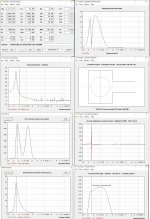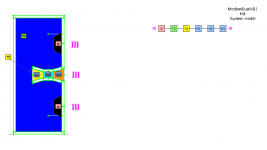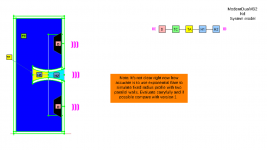love it!!sigh Wish I had 8 of those, if only for bragging rights...
View attachment 1105223
I'd say that's a pretty good number for a total of less than 5000Watts of power.
so what is the recommended processor settings, and cab plans 😉 , i have a dbx rta mic. so i will start learning REW just enough to take some outside on the ground measurements 2Pi right? , also i need to look for cabinets grills and feet, also i want my sides and corners "roundish" like the pro cabinet , then some bedliner , duratex or some hybrid, i love DIY brews! lol.
ohh ic BW 30Hz LP/24db and 150Hz HP/24db, so BW works better on this design than LR , can we do a port design similar to the 18sound pic i pasted on past posts on this thread or bass boss type of thing, those round circles (tube pipe ports) look 80's , a friend of mine will help me with the wood cut and assembly, hope that with 2 sheets we can coax one cab out.
I calculated the sim with emphasis on a slot port, because it would be beneficial for structural integrity. No round ports here.
Funny that you consider round ports to be old school.
Edit:
Bessel and Butterworth filters at 24dB/oct give similar results in this design, if possible I would use Bessel for the 150Hz HP, you can push the crossover higher if you want to.
Funny that you consider round ports to be old school.
Edit:
Bessel and Butterworth filters at 24dB/oct give similar results in this design, if possible I would use Bessel for the 150Hz HP, you can push the crossover higher if you want to.
Last edited:
10-4 Senor!I calculated the sim with emphasis on a slot port, because it would be beneficial for structural integrity. No round ports here.
Funny that you consider round ports to be old school.
Edit:
Bessel and Butterworth filters at 24dB/oct give similar results in this design, if possible I would use Bessel for the 150Hz HP, you can push the crossover higher if you want to.
You need about 2 and a half sheets for 2 boxes.
5 sheets for 4 boxes, which looks like it can give you a very nice 94% yield!
I'm using metric, just punched in some numbers using a cut list optimizer, this is including some bracing.
https://www.opticutter.com/cut-list-optimizer/

5 sheets for 4 boxes, which looks like it can give you a very nice 94% yield!
I'm using metric, just punched in some numbers using a cut list optimizer, this is including some bracing.
https://www.opticutter.com/cut-list-optimizer/
ok ,
so last calculations was for a double 15 box? or single? i got lost 🙁
if double then
looks im going headed towards a 330L double 15 BR box
PRV 15SW2000 drivers
Big thanks to Kaffi who was kind to calculate the hornresp and cut list for the box on his scarce free time gaps , still pending is the assembly layout diagrams
i need help ,somebody with sketchup chops and port knowledge so to sketch the box and layout the port shape size.
so last calculations was for a double 15 box? or single? i got lost 🙁
if double then
looks im going headed towards a 330L double 15 BR box
PRV 15SW2000 drivers
Big thanks to Kaffi who was kind to calculate the hornresp and cut list for the box on his scarce free time gaps , still pending is the assembly layout diagrams
i need help ,somebody with sketchup chops and port knowledge so to sketch the box and layout the port shape size.
Last edited:
the size of the Kaffi box is like the yamaha cw218 but with the PRV drivers we can hit lower than the yamahas, is that correct?
You should be able to figure this out 😉 its just a tube of a specific cross sectional area and length.i need help ,somebody with sketchup chops and port knowledge so to sketch the box and layout the port shape size.
lol i dont like tubes, i like bass boss style vents, Lacostics KS28 yeah but cant make those flares, 18sound cabinet vents are nice also, any but ugly tubes
fact is that i dont know how to tune calculate all the acoustics involved, im being guided by Kaffi
fact is that i dont know how to tune calculate all the acoustics involved, im being guided by Kaffi
Last edited:
aha ok read this paper: https://www.diyaudio.com/community/attachments/harman-port-study-pdf.893225/
what i can see is the flared ports are the best no wonder KS28's used them, but i do not have the industrial machines to make em, i think i will need to stick to some rectangular designs,aha ok read this paper: https://www.diyaudio.com/community/attachments/harman-port-study-pdf.893225/
you can make a KS28 style port with bendable ply or kerf material and formers cut using a jigsaw using printed templates.what i can see is the flared ports are the best no wonder KS28's used them, but i do not have the industrial machines to make em, i think i will need to stick to some rectangular designs,
can somebody take a look at the hornresp, just want to double check before starting to do the actual cutting.
Maxolini,
The plan for KS28 is available as the name of ModernDualVB2, The curved flared for the vent is simulated as exponential flare, we don't know precisely how accurate it is, but also talking with David it looks a good approximation. ModernDualVB1 is also an option with 3 parabolic segments which for sure is accurate.
Beside we suggested previously, I would just to reinforce to you to use CAD software to check your Hornresp data. Everything was already done for you, you would be surprised how easy it's to use. Is a kind of step you need to do it before you spend money cutting wood. I don't think other mate would take this risk for you. You just need to adjust the dimensions inside the model and hornresp input data will change automatically, you can see trough the embedded spreadsheet so you compare with your simulation. See attachment #3.
The plan for KS28 is available as the name of ModernDualVB2, The curved flared for the vent is simulated as exponential flare, we don't know precisely how accurate it is, but also talking with David it looks a good approximation. ModernDualVB1 is also an option with 3 parabolic segments which for sure is accurate.
Beside we suggested previously, I would just to reinforce to you to use CAD software to check your Hornresp data. Everything was already done for you, you would be surprised how easy it's to use. Is a kind of step you need to do it before you spend money cutting wood. I don't think other mate would take this risk for you. You just need to adjust the dimensions inside the model and hornresp input data will change automatically, you can see trough the embedded spreadsheet so you compare with your simulation. See attachment #3.
Attachments
Lord,
i think i did not explained myself, what i mean is i like the KS28 flares but not that i want to build one, the drivers are not on my budget, on the double 15 kaffi was working on , i choose the driver at 190 bux each,
i like how the graph spl graph looks, the driver is on budget, i wish i know how to calculate and draw the ports so the response remains.i guess i need to wait till Kaffi reveals how he calculated the ports and draw the vents, the baffle layout is still a mistery.
i think i did not explained myself, what i mean is i like the KS28 flares but not that i want to build one, the drivers are not on my budget, on the double 15 kaffi was working on , i choose the driver at 190 bux each,
i like how the graph spl graph looks, the driver is on budget, i wish i know how to calculate and draw the ports so the response remains.i guess i need to wait till Kaffi reveals how he calculated the ports and draw the vents, the baffle layout is still a mistery.
Last edited:
It's confusing to understand what you are doing.
There are many different layout and solutions, it doesn't Mather the size of driver, you adjust the box dimensions accord.
You don't need Kaffi, looking to it's simulation, you can see through the Hornresp inputdata screen that he simulated a offset drive, you can see the OD indication with RED color, and the value is 2P because he use 2 parallel drivers.
You can also see that the Volume of rear Chamber (Vrc) is 0 and the Volume of Throat Chamber (Vtc) is also 0, so he is simulating a kind of transmission line for you. He uses 4 segments , they are:
S1 S2 + lenght + flare type
S2 S3 + lenght + flare type
S3 S4 + lenght + flare type
S4 S5 + lenght + flare type
You can see the he uses constant area (same number repeatably), so the the transmission line has no flare it's straight, in the transmission to the last segment he reduces a lot the cross section area from 5096cm^2 to 624cm^2.
Your first step could be trying to replicate that simulation on hornresp. If you mouse over any input it will give you an indication about what it is.
Check in the website below the models: MLTL, MLTL2 and MTL3, they probably will give you better results due to it's flare in the segment 1 and 2. Check also the models TL1 and TL2. In the website you can find colored models, witch helps you to better understand hornresp inputs.
https://freeloudspeakerplan.rf.gd/
There are many different layout and solutions, it doesn't Mather the size of driver, you adjust the box dimensions accord.
You don't need Kaffi, looking to it's simulation, you can see through the Hornresp inputdata screen that he simulated a offset drive, you can see the OD indication with RED color, and the value is 2P because he use 2 parallel drivers.
You can also see that the Volume of rear Chamber (Vrc) is 0 and the Volume of Throat Chamber (Vtc) is also 0, so he is simulating a kind of transmission line for you. He uses 4 segments , they are:
S1 S2 + lenght + flare type
S2 S3 + lenght + flare type
S3 S4 + lenght + flare type
S4 S5 + lenght + flare type
You can see the he uses constant area (same number repeatably), so the the transmission line has no flare it's straight, in the transmission to the last segment he reduces a lot the cross section area from 5096cm^2 to 624cm^2.
Your first step could be trying to replicate that simulation on hornresp. If you mouse over any input it will give you an indication about what it is.
Check in the website below the models: MLTL, MLTL2 and MTL3, they probably will give you better results due to it's flare in the segment 1 and 2. Check also the models TL1 and TL2. In the website you can find colored models, witch helps you to better understand hornresp inputs.
https://freeloudspeakerplan.rf.gd/
Lordsansui,
Kaffi calculated a 330 liter dual 15" bass reflex enclosure, we was looking at the yamaha CW218 dual 18 cabinet, i settled for a 15 driver the PRV 15SW2000 , so the horn resp data is that drivers on a 330 liter box, no tapped horn or anything, just a dual 15 front firing box, since i do not want to use round vents , kaffi is doing some square vents, that are not posted yet, hope this clarify some your questions, all is in the thread but is getting long now.
i will post the real life freq response and build pics on another thread when i get the final plans and start the assembly.
right now i just need help to check that all match , you guys have many hours of flght time with horn resp, to me looks ok but im not expert.
Kaffi calculated a 330 liter dual 15" bass reflex enclosure, we was looking at the yamaha CW218 dual 18 cabinet, i settled for a 15 driver the PRV 15SW2000 , so the horn resp data is that drivers on a 330 liter box, no tapped horn or anything, just a dual 15 front firing box, since i do not want to use round vents , kaffi is doing some square vents, that are not posted yet, hope this clarify some your questions, all is in the thread but is getting long now.
i will post the real life freq response and build pics on another thread when i get the final plans and start the assembly.
right now i just need help to check that all match , you guys have many hours of flght time with horn resp, to me looks ok but im not expert.
Well, no one said rounded vent nor tapped horn, I just interpret the hornresp data for it's simulation. It can be a vented slot too but your last post confirm you are not understanding so I can't help you further.
- Home
- Loudspeakers
- Subwoofers
- Dilema on what route to take double 18s reflex or TH



